Choosing Peppers for Garlic Sriracha Hot Sauce
To make your own garlic sriracha at home, you need to start with quality peppers. Here’s my checklist for choosing good peppers:
- Density: The peppers should feel like they are hydrated and have good turgor pressure. It should not feel dried out, shriveled up, and floppy.
- Check for surface mold: Look for indentions and soft spots in the peppers. You do not want to buy peppers that are squishy. Peppers that are close to molding will have dark, small, circular indentions or black “pocks” on the surface and near the stem.
- Skip the bag: It’s important to note here that you should NOT use peppers that come “triple-washed” in a plastic bag. Or frozen peppers. These do not wild ferment well (or at all, really) because they lack the microorganisms necessary for the fermentation process.
- Color: Peppers should have a uniform color, but some peppers do change colors as they ripen. For example, it’s fine to use a jalapeno that is green and may also have some reddish colors.
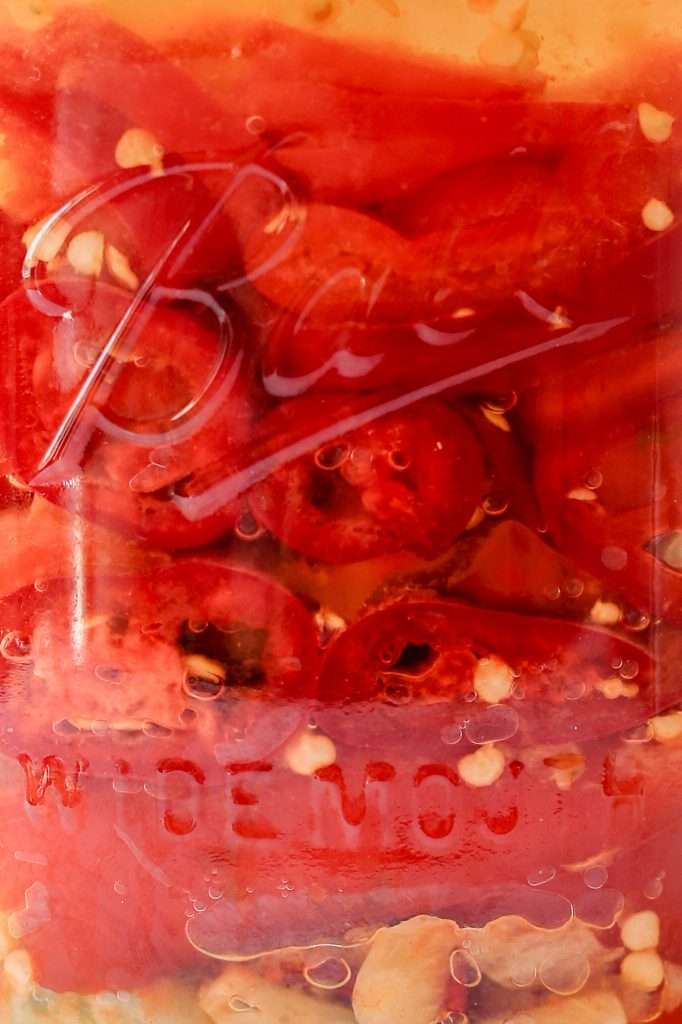
Fermented Garlic Sriracha Hot Sauce
You can use various peppers to make fermented sriracha hot sauce, but red jalapenos work best. We have a Latin food market in town, and I can always find red jalapenos there.
Other good options for red peppers include Cayenne or Red Anaheim. I’ve made a batch of this garlic sriracha with a mix of all three and it was amazing. Note that different peppers will yield variable heat levels.
If you are looking to make other kinds of hot sauce, you can use this recipe blog with just about any pepper type.

Also, I want to mention that some peppers contain too much capsaicin, so no beneficial fermentation microbes can grow when fermenting those. I’m talking about peppers above 500,000 Scoville units (Trinidad Scorpion, Komodo Dragon, Carolina Reaper, Ghost Pepper, Naga Viper, etc.). I wouldn’t be surprised if there aren’t any fermentation bacteria on the surface of a Carolina Reaper pepper, for instance. At such a high concentration, capsaicin is bactericidal.
If you want to ferment extremely hot peppers, mix them in with more mild peppers.
If you’re looking to mix peppers and try other kinds of hot sauce besides sriracha with this recipe, I suggest trying:
- Serrano Peppers
- Poblano Peppers
- Jalapeños
- Habanero
- Anaheim Peppers
Fermenting Peppers for Hot Sauce
Regarding fermentation times, the longer the peppers ferment, the more the flavor develops. I love peppers that have been fermented for about five weeks. After five weeks, they’re perfectly tart and preserved, ready to be made into hot sauce.
When fermenting peppers, it’s better to use a slightly higher salt concentration than for other vegetables; about 3.5% of the total weight in salt is a good place to start. I like peppers fermented anywhere between 3% and 6% total salt concentration. (Read more about salt concentration here).
While some people make hot sauce by blending and mashing the peppers first, I do not. I prefer to ferment everything in slices, so it all stays submerged with a fermentation weight during the 5-6 weeks of fermentation. Once fermentation is complete, it’s time to cook it down and blend it into a sauce.
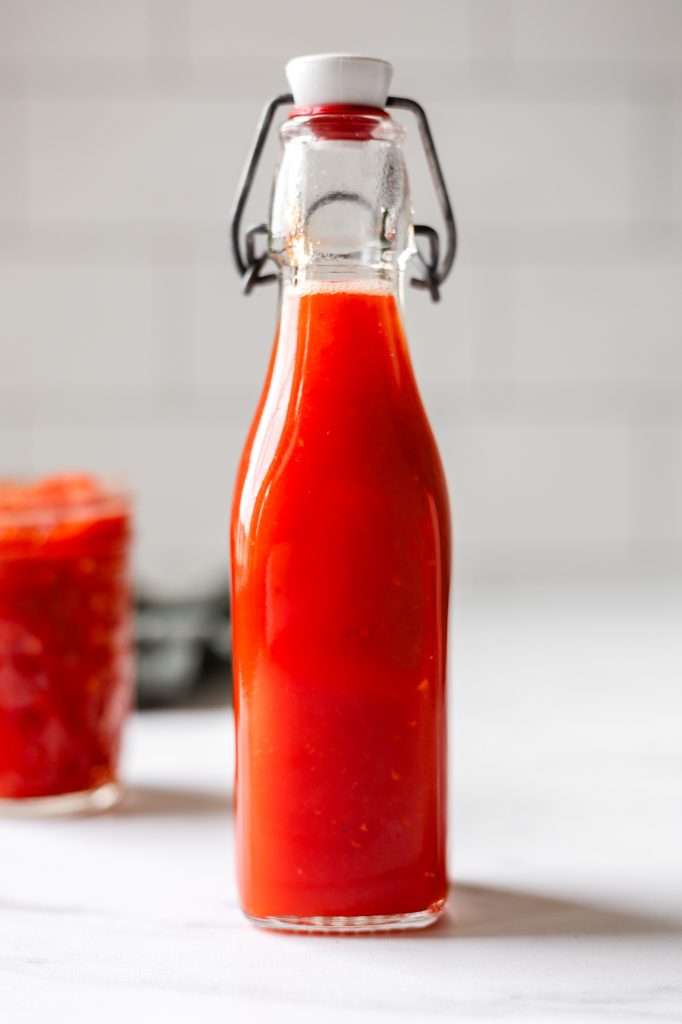
Supplies You Need to Make Garlic Sriracha
- 32 ounce Wide Mouth Mason Jar
- Fermentation Weight
- Standard Metal Mason Jar Lid (this can rust in the presence of salt)
- OR Rust Free Plastic Lid
- or you can use a Weck Jar (without the gasket; only use the clips to secure the lid)
- Sea Salt
- Scale
- Mixing Bowl
- blender
- pot for cooking
To learn more about the best fermentation jars and lids to use, CLICK HERE.
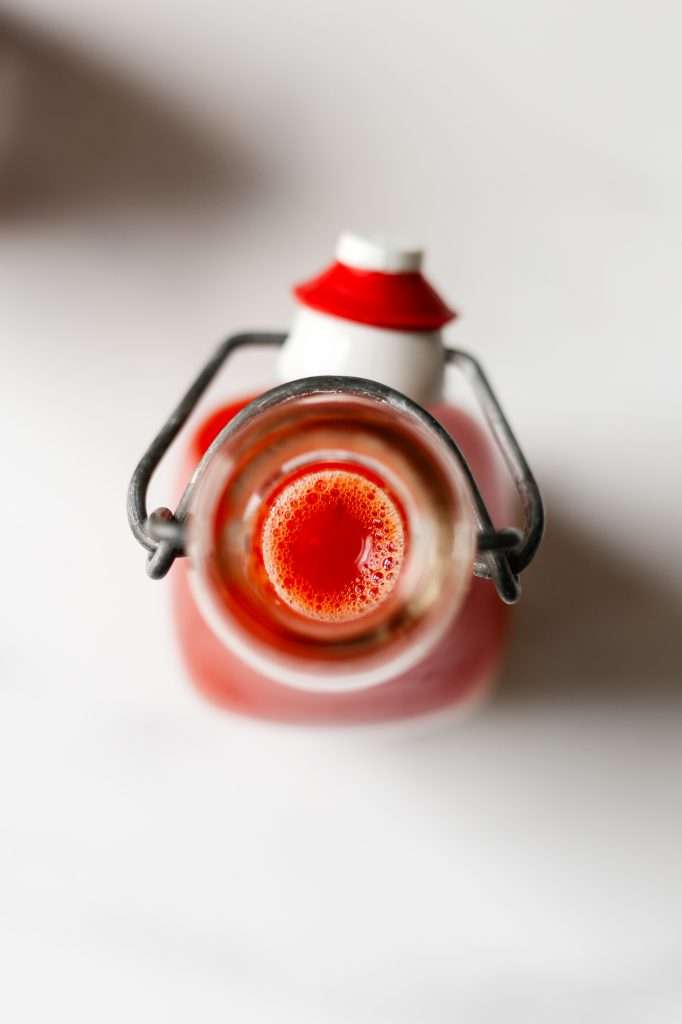
How to Ferment Sriracha Hot Sauce
The process starts by wild fermenting peppers and garlic for five weeks at room temperature.
During the first few days of fermentation: carbon dioxide and bubbles will be produced. Sometimes, jars will become very full of liquid, and this liquid can seep out. It’s important to “burp” the jar during the bubbly stage.
- If using a standard mason jar lid: remove the lid and tamper everything back down using a gloved hand, tamper, or spoon. Make sure everything is still submerged below the brine, and re-secure the lid.
- You may notice pepper seeds floating. You can scoop them out with a clean spoon.
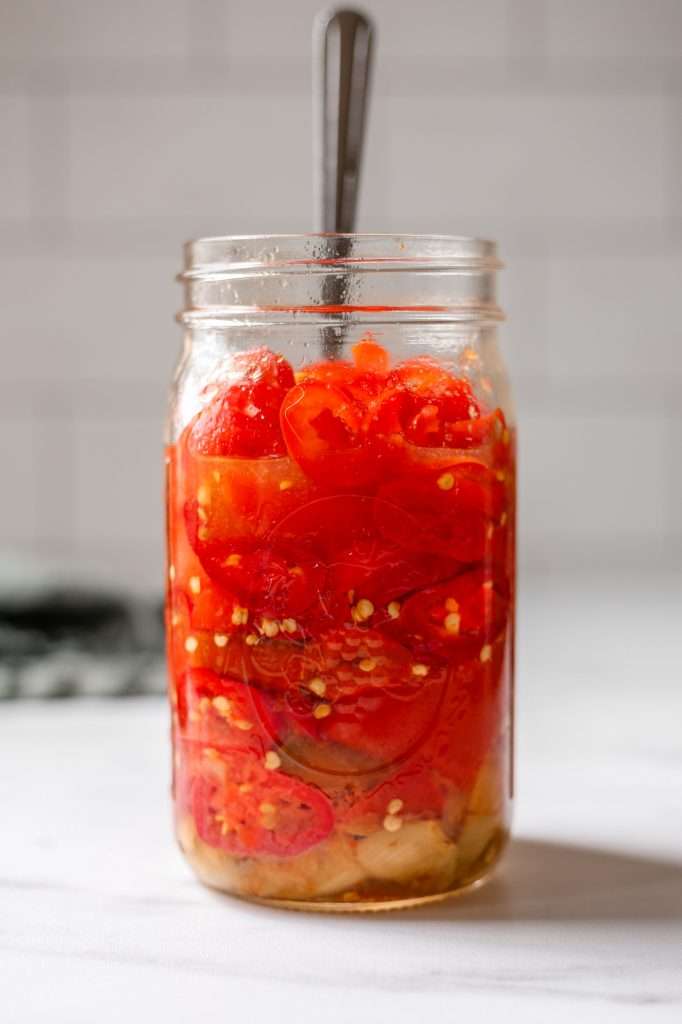
Hot Sauce Fermentation Timeline
Here is the timeline of pepper fermentation at a moderate room temperature (about 76° F).
24 – 72 hours: All contents in the jar should be submerged beneath the brine. At this time there are still Gram negative bacteria and possible pathogens present.
72 hours – 9 days: After 72 hours you should start to see lots of bubbles being produced. This is the stage in which you will burp the jar (open the lid and make sure everything is submerged below the brine). This is when the ferment enters stage two of vegetable fermentation. Leuconostoc bacteria begin to thrive and produce a lot of carbon dioxide. Gram negative organisms die off. You may notice an acidic smell and color changes during this time.
9 – 14 days: The bubbles in the brine will decrease as the ferment leaves stage two and enters stage three. The peppers will become cloudy and start to develop a pleasant sour smell. They will also start to change color from vibrant to more muted colors. Lactobacillus species are most abundant during this period.
14 – 28 days: Lactobacillus comprise most or all of the microbial population. They produce copious amounts of lactic acid, making the ferment smell even more pleasantly sour. This is the time in which the pepper and garlic mixture becomes preserved.
30 days: Wait for the peppers to smell and taste as you like, then move on to blending and cooking the hot sauce. (We cook it because we add sugar to the hot sauce and want the sweetness to remain in the flavor profile. This kills the microbes, but makes for the best flavor).

How to Make Hot Sauce
Once the peppers and garlic are finished fermenting, it’s time to make the sauce. Here’s how you turn the fermented jalapenos and garlic into sriracha:
- Add all of the fermented peppers, garlic and brine to a blender with the sugar and vinegar. Blend on high until smooth.
- Scoop everything from the blender into a pot and cook for about 10 minutes at a simmer.
- Place a colander over a large bowl and strain the sauce. You can mash the pulp a little with a spoon to get all the juices out. (don’t forget to save the pulp!)
- Return the strained liquid to the same pot and cook for 10-15 more minutes at a simmer.
- Using a funnel, bottle the sauce. Wait to cap the bottle until the sauce cools down a little.

Bottling and Using All Parts
Since you strain the sauce, you will have some pepper pulp left over. Please do not throw it away! Put it in a mason jar and keep it to cook with. It is fantastic in soups, stews, braises, and especially ramen.
Essentially this recipe gives you two sauces, garlic sriracha hot sauce, and a garlic pepper paste. yay!



How to Make Fermented Garlic Sriracha Hot Sauce From Scratch
Learn how to make your own fermented garlic sriracha hot sauce at home. It’s easier (and cheaper) than you think! To make sriracha you’ll need red jalapenos. However, this recipe can be adapted to make garlic hot sauce with many types of hot peppers.
- Prep: 10 minutes
- Cook: 30 minutes
- Total Time: 840 hours 40 minutes
Ingredients
- 700 grams red jalapeños
- 50 grams garlic
- 180 grams water
- 40 grams salt
- 100 grams sugar (after fermentation)
- 100 grams vinegar (after fermentation)
Instructions
- This recipe at 1x works best with a 32-ounce jar for the fermentation and a 12-ounce bottle for the sauce. Wash your fermentation equipment, including the jar, weight, and lid.
- Wash your jalapenos and slice them. (Wear gloves if you are sensitive to peppers). Crush and peel the garlic.
- Place your kitchen scale on the counter. Turn it on and set it to weigh in grams. Place a mixing bowl on your kitchen scale and tare/zero the scale.
- Add your peppers and garlic into the bowl, measuring out the designated amount.
- Remove the bowl from your scale and set it aside. Place your empty, clean mason jar on the scale, and tare/zero the scale. Ensure your scale is still set to grams, and add the designated amount of filtered water to your mason jar.
- Place a small bowl on your scale and tare/zero the scale. Weigh out the sea salt. Then add the salt to the jar with the water. Stir until all the salt is dissolved.
- Add the peppers and garlic from your bowl, into the mason jar with water. You will need to mash the peppers into the jar with a tamper or wooden spoon to pack them in, as you do the brine will come up.
- Place your fermentation weight in the jar making sure to submerge all of the pepper pieces and weight fully in the liquid.
- Secure the lid to the jar and ferment at room temperature for 5 to 6 weeks.
- After fermentation, add all of the fermented peppers, garlic, and brine to a blender with the sugar and vinegar. Blend on high until smooth.
- Scoop everything from the blender into a pot and cook for about 10 minutes at a simmer.
- Place a colander over a large bowl and strain the sauce. You can mash the pulp in the colander with a spoon to get all the juices out. (don’t forget to save the pulp!)
- Return the strained liquid to the same pot and cook for 10-15 more minutes at a simmer with regular stirring.
- Using a funnel, bottle the sauce. Wait to cap the bottle until the sauce cools down a little.
- Store in the refrigerator. Use within a year for the best flavor.
Notes
- You can use other peppers in this recipe. Peppers above 500,000 Scoville units contain an extremely high concentration of capsaicin. At those levels, capsaicin is bactericidal and can prevent natural fermentation. Choose your peppers accordingly.















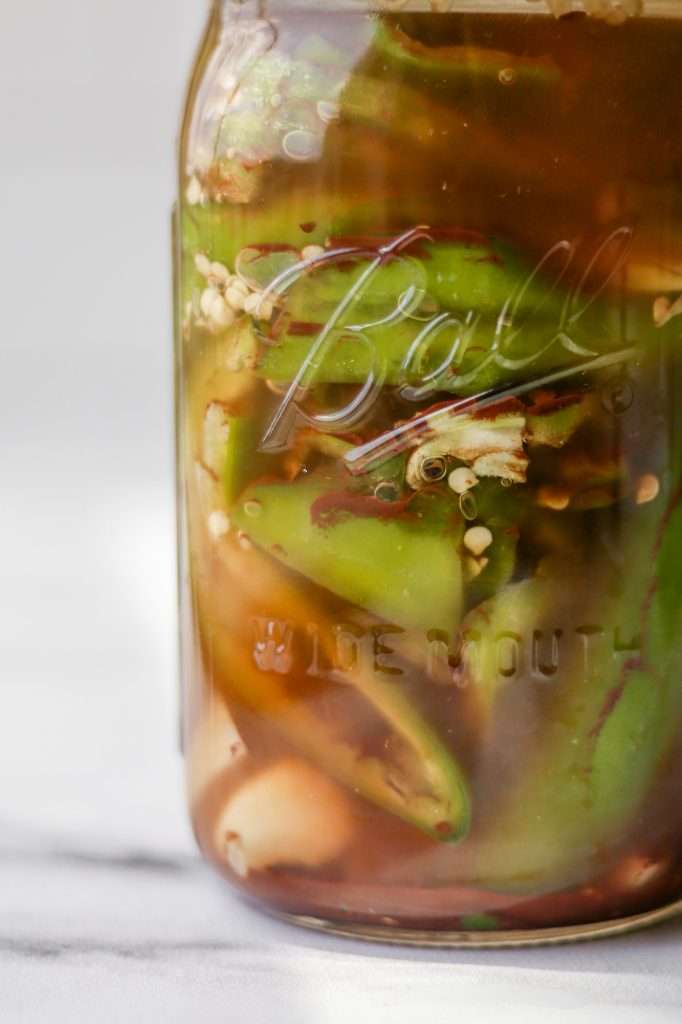



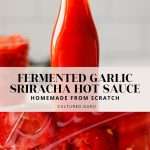

Hi! Can you use fresh peppers that have been frozen? I bought a bunch and didn’t know what to do with that amount so I froze them for chili but I wouldn’t mind another option.
They might work, maybe tray a mix of fresh and frozen. I’ve never tried it with frozen peppers so I don’t know for sure.
Thanks! I’ll give it a go!
Hello, Do you remove most of the seeds before fermenting? Thank you.
I don’t make it a point to remove all the seeds. A lot of them fall out when slicing, and I leave those out.
Hi, When finished fermenting the brine ph was 5.5 but after processing with vinegar and sugar the ph dropped to 4.5. I then simmered everything for 10 minutes and separated the pulp form the liquid and simmered the liquid another 10 minutes. Even though the ph is a little elevated would the sauce and pulp be safe to eat? Thank you
What kind of peppers did you use, and how are you testing the pH. When testing this recipe twice, my peppers were 3.5 pH before turning them into sauce, so I’m curious what is different about yours?
I used Calabrian Ristra, a hot Italian pepper. The ph strips used are for kombucha which I used on your sauerkraut and giardiniera and they seem to be accurate. I did make only half a recipe and possibly my calculations were off causing the higher ph. Also, this ferment might have been all frozen peppers or some frozen mixed with fresh.
Okay, those peppers can be 3-16 times higher on the scoville scale, so that along with using frozen peppers is the problem. Probably not enough natural microbes to get the fermentation going correctly. You should always use fresh produce with my recipes. If the pH was high before you turned it into sauce, I cannot recommend eating it still. It’s an eat at your own risk situation.
Ok, I will heed your advice and not consume this and chalk it up to experience. I have a lot of peppers frozen from my garden and want to use them to make hot sauce. Is there anything that can be added to the peppers to jumpstart the fermentation and enable it to complete the fermentation process? Thank you.
I was surprised to see that you cook and add vinegar to the ferment. I would think you would want the fermentation for the health benefits ie gut health , think sauerkraut or kimchee.?
I eat sauerkraut, kimchi, fermented pickles, raw vinegar and homemade yogurt daily. So I don’t require live bacteria from hot sauce. I talk about this in the blog post. I wanted a sweet and spicy flavor profile; in order to add sweetness, and for the sweetness to remain, it needs to be cooked. Live bacteria is not the only benefit of fermentation. Fermentation also gives us unique flavors, digestibility and bioavailable nutrients.
Hi! My peppers are ready to turn into hot sauce but I’m a bit worried. I notice a white film on the top layer and over the fermentation weight. Is that ok? Or normal? I do see active bubbles especially when I move the jar. Any thoughts? I hate to have wasted all that time and ingredients. Thanks!
Sounds like yeast (commonly called kahm). It happens with some peppers and is perfectly normal. You can scoop it off the top with a spoon, then proceed with the next steps.
Thank you! I did and it came out great!
I made this and it smells great however I have questions. When I opened the jar it smelled very good and there was no Kahn yeast and just a little spent lacto on top of the weight. The brine ph was 5.5 but after processing with vinegar and sugar the ph dropped to 4.5. I then simmered everything for 10 minutes and separated the pulp form the liquid and simmered the liquid another 10 minutes. Even though the ph is a little elevated would the final sauce and pulp be safe since it was cooked? Really appreciate your website and input.
Aaaaaaaah. I didn’t read the.directions carefully. I added the sugar and the vinegar to the peppers before fermenting. Will it still work?? How do I save it? The ingredients were too expensive to go to waste. Help!!!!!
I’m unsure what will happen, or if you can fix it because I’ve never made this mistake to test it.
Oh it tastes amazing? But how can I make or is this recipe shelf stable??
I’m not sure, I don’t dabble in shelf stable canning or bottling. I’m glad you enjoy the flavor though!
I have used a slightly different recipe that stays raw to the end, but I have been experimenting with a bottle of it on my desk at work with just refilling from home, and it is very desk / shelf stable!! E-mail me if you want my recipe.
I made the a few months ago and I back to make more as my bottle is all gone! It was that good! I love a good hot sauce but I hate when all it brings is heat and no flavor. This sriracha brings both beautifully! I got so many compliments on it! Thank you for sharing the recipe with us!
Hi! I am currently doing this recipe and am on week 3, but during the burping process I seemed to have lost SO much brine. I have about an inch of liquid in my jar, is that normal or did I do something wrong? It seems like there is a weird white film now throughout as well, thinking it’s from the lack of liquid? I also weighed everything correctly to the gram, and used a 32 ounce mason jar and tampered everything down and also lost brine when I put the weight in and had to remove peppers because it was just too full. I feel like I did something wrong but I followed all the instructions to a T. Any advice?
The peppers should all be covered in brine throughout the entire fermentation process. These measurements work great for me every time, but I really mash the peppers into the jar with a tamper at the start, and check the jar daily to tamper everything back down below the liquid. I also screw the lid onto the jar, but I don’t tighten it all the way so it does not carbonate too much.
Well dang. I will have to try again. Thanks for the help!
I’m so excited about this recipe as we love sriracha but stopped eating it because of all the unpronounceables in the ingredient list of shop bought.
My chillies are ready tomorrow and I have a quick question about the process. We really want to keep some bacteria if we can. Do you think it would work if I held back a small amount of the chillies, blended them separately then re-added them once the other chillies were cooked and cooled? I’m guessing the bacteria would then spread back through the sauce? I’m trying for the best of both worlds 🙂
if you do that, it will start fermenting again, and it will become more sour, no sweet flavors. Gas may build up in the jar too.
to keep the sauce longer its best to close the lid and turn the bottle upside down when the sauce is still quite hot.
this will make a vacuum when the sauce cools and will pull the lid real thight so no oxygen wil contaminate and spoil the sauce. i have one bottle of a batch i made 3 years ago and it is still under vacuum. and no spoilage in sight!
I keep it refrigerated, and direct people to do so in the recipe. It doesn’t need to be vacuum sealed. A batch I have in the fridge is 2 years old and as delicious as the day I made it.
I can’t officially rate the recipe as I’m mid ferment! But I’ve opened it a few times and it smells spicy!
I was wondering about adding peaches to add a twist to it! Have you ever added any fruits post fermentation? Have any tops and tricks for me?
I have! I’m actually posting a recipe later this week for a blueberry hot sauce, and I processed it with blueberry jam! essentially the same recipe as this garlic sriracha hot sauce, but blueberry jam instead of sugar.
what do you do with the pulp?
I cook this ramen a ton in the fall/winter and I use the pulp in it, instead of the actual sauce. Slow Cooker Spicy Beef Ramen Made with Chuck Roast
I may just be missing something very simple, but I’m stumped here. The recipe calls for 180g of water and 40g salt. Doesn’t that result in a solution that is something like 18% salt? I thought I saw in another one of your articles that the max salt content should be around 10%, but 6% is better. Isn’t this something like 3X the salt content, which would not allow fermentation to begin?
Fresh, raw peppers are about 92% water. So the weight of the peppers has to be factored into the total salt concentration, because they contribute a significant amount of water to the recipe. This recipe has an approximate 4.5% total salt concentration.
Ahh, thank you! I think I see what you’re saying, and as a result the total solution should be something like 4.63% salt. Thank you for clarifying that.
Anyway, since I didn’t factor in the pepper’s water mass, it looks like I have a batch that is sitting in about a 9.3% salt solution because I only used 350g of peppers. I was trying to do a half recipe but, interestingly, this recipe created exactly as much brine as it took to fill 2 half-pint jars stuffed with a total of 350g of peppers. If it’s at 9.3% salt though, I guess it will ferment, but I’m guessing it may start slow. I’ll update if I get particularly good or bad results.
Ok, so what do you think if I made the fermentation 9-10 months ago but never finished separating and making the sauce (I put it in a back shelf and never got to it). It smells fantastic – almost vinegary…
I love long-fermented peppers. I’ve let some ferment for 2 years then made sauce. You can just make it now.
THANK YOU. I really love your recipes. Great web sight
.
Would you know if the fermenting process will remove the lectins?
Lactic acid bacteria involved in the fermentation of peppers and other vegetables produce enzymes that break down various anti-nutrients. While specific research on lectin degradation during pepper fermentation is limited, we do know that lactic acid bacteria significantly reduce lectins in other fermented foods. There are studies on lactic acid fermentation reducing lectins by 98% in bean fermentation, so I assume they have the same effect on lectins in peppers.
How do I make it thicker?
cook it longer
Would love a shelf stable recipe
I’ll look into it! But I don’t ever do shelf stable sauce recipes in my day-to-day.
Perfect
Hi
If you cook the fermented peppers
Isn’t it killing all the good bacteria ?
Why ferment if you are heating the peppers after?
Thank you!
I am
Making harissa and looking into fermented harissa. But I am confused about the cooking.
We cook it because we add sugar to the hot sauce and want the sweetness to remain in the flavor profile. Balanced sweet and heat flavors are signature to sriracha. Heating kills the microbes, but makes for the best flavor. There are other benefits to fermentation besides live probiotics, such as flavor, lactic acid preservation, and digestibility.
Thanks for all your content! I am about a week into this recipe. When I first made it the peppers were so tighly packed down! I tamped just like you instructed and everything barely fit but I coudlnt get all the brine to fit. Every time I burp the jar I loose some brine, there are lots of air pockets in the jar, is that normal? May I tamp again midway through and add some brine?
Thanks! Going to try the habanero recipe next.
You can open up the jar to tamp down and check to see if the lid is clean as often as you want! I suggest adding a splash of raw ACV to replace lost brine if necessary (this does not hurt lactobacillus). You don’t want to add salt water, as that will oxygenate things and dilute the acidity.
First of all, thank you ‘cultured guru’ for sharing all these great recipes. I am trying the sriracha one and I noticed that the visible fermentation seems slower than some of the other ones based on your other recipes. I calculated the salt percentage and it seems to be around 4%. Your recommendation is between 3-6%.
Is a slower fermentation process to be expected?
I am fermenting Korean hot peppers with a few jalapenos + garlic.
slower fermentation is expected with super hot peppers, and with higher salt. As long as you’re seeing some bubbles and activity in the jar, even if it’s slight, it’s good to go!
60 days later I got the sugar and vinegar + the fermented peppers, etc. into the blender, WOW – what a treat!!! Thank you Cultured Guru for this recipe! The only thing I did not follow was straining the final sauce, my blender did a decent job to make the sauce very smooth. A well deserved 5 Stars 🙂
amazing! Thank you for leaving a review! I’m thrilled to hear you love the recipe.